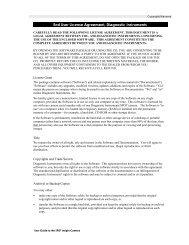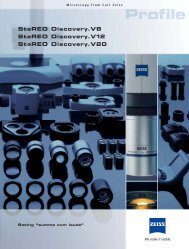optical interference filters - SPOT Imaging Solutions
optical interference filters - SPOT Imaging Solutions
optical interference filters - SPOT Imaging Solutions
Create successful ePaper yourself
Turn your PDF publications into a flip-book with our unique Google optimized e-Paper software.
I<br />
R<br />
O<br />
P<br />
Q<br />
Intensity Crosstalk: Intensity crosstalk occurs between<br />
channels and is a result of non-ideal <strong>optical</strong> filtering, where<br />
light from neighboring channels can leak through and be<br />
detected along with the filtered signal of interest. When the<br />
leakage level of a neighboring channel is higher than the<br />
noise floor that is associated with the channel of interest, it<br />
becomes the dominant noise factor in the SNR. As a rule<br />
of thumb, the intensity crosstalk of neighboring channels<br />
must be at least 20 dB below the target signal level. This<br />
type of crosstalk can be dealt with by using a high quality<br />
<strong>optical</strong> filter to eliminate all unwanted signals outside of the<br />
target channel bandwidth.<br />
Interference Filter: An <strong>optical</strong> filter consisting of multiple<br />
layers of evaporated coatings on a substrate, whose spectral<br />
properties are the result of wavelength <strong>interference</strong> rather<br />
than absorption.<br />
Ion-assisted Deposition: A technique for improving the<br />
structure density of thin-film coatings by bombarding the<br />
growing film with accelerated ions of oxygen and argon.<br />
The kinetic energy then dissipates in the film, causing the<br />
condensed molecules to rearrange at greater density.<br />
Optical Density (OD): Units measuring transmission<br />
usually in blocking regions. Conversion: -log¹⁰T = OD. For<br />
example, 1% transmission is .01 absolute, so -log¹⁰ (0.01)<br />
= OD 2.0.<br />
Optimized Blocking: To conserve the most energy in<br />
the transmission band by controlling only the out-of-band<br />
region of detector sensitivity.<br />
Peak Transmission (Tpk): The maximum percentage<br />
transmission within the passband.<br />
Polarization: At non-normal AOI, an <strong>interference</strong> filter’s<br />
spectral performance in p-polarized light will differ from its<br />
performance in s-polarized light.<br />
Protected Coatings: The process by which two or more<br />
substrates, coated with thin film depositions, are assembled<br />
together using an index-matching <strong>optical</strong> epoxy.<br />
QMAX or QuantaMAX: Surface coated single substrate<br />
designs with steep edges, very high transmission and no<br />
registration shift.<br />
S<br />
T<br />
Reflection (R): The return of light from a surface with no<br />
change in its wavelength(s).<br />
Signal to Noise Ratio (S/N): The system ratio of the<br />
integrated energy within the passband envelope to the<br />
energy outside this envelope and within the free spectral<br />
range.<br />
Slope: The rate of transition from attenuation (defined<br />
as 5% of peak transmission) to transmission (defined as<br />
80% of peak transmission). Slope = (lambda 0.80 - lambda<br />
0.05) divided by lambda 0.05.<br />
SP: Shortpass <strong>filters</strong> transmit wavelengths shorter than the<br />
cut-off and reflect a range of wavelengths longer the cutoff.<br />
Surface Quality: Allowable cosmetic flaws in an <strong>optical</strong><br />
surface by comparison to reference standards of quality;<br />
usually made up of two types of standards defining long<br />
defects (such as scratches) and round defects (such as<br />
digs & pits).<br />
System Speed: When filtering a converging rather than<br />
collimated beam of light, the spectrum results from the<br />
integration of the rays at all of the angles within the cone.<br />
The peak wavelength shifts about one-half the value that it<br />
would shift in collimated light at the cone’s most off angle.<br />
Temperature Effects: The performance of an <strong>interference</strong><br />
filter shifts with temperature changes due to the expansion<br />
and contraction of the coating materials.<br />
Thin Film: A thick layer of a substance deposited on an<br />
insulating base in a vacuum by a microelectronic process.<br />
Thin films are most commonly used for antireflection,<br />
achromatic beamsplitters, color <strong>filters</strong>, narrow passband<br />
<strong>filters</strong>, semitransparent mirrors, heat control <strong>filters</strong>, high<br />
reflectivity mirrors, polarizer’s and reflection <strong>filters</strong>.<br />
Transmission: The fraction of energy incident upon the<br />
filter at any particular wavelength that passes through the<br />
filter. Expressed as either percent (95%) or a fraction of 1<br />
(0.85).<br />
Transmittance (T): The guaranteed minimum value of the<br />
peak transmittance of the filter (not necessarily occurring at<br />
the centre wavelength).<br />
For current product listings, specifications, and pricing:<br />
www.omega<strong>filters</strong>.com • sales@omega<strong>filters</strong>.com<br />
1.866.488.1064 (toll free within USA only) • +1.802.254.2690 (outside USA)<br />
111

















